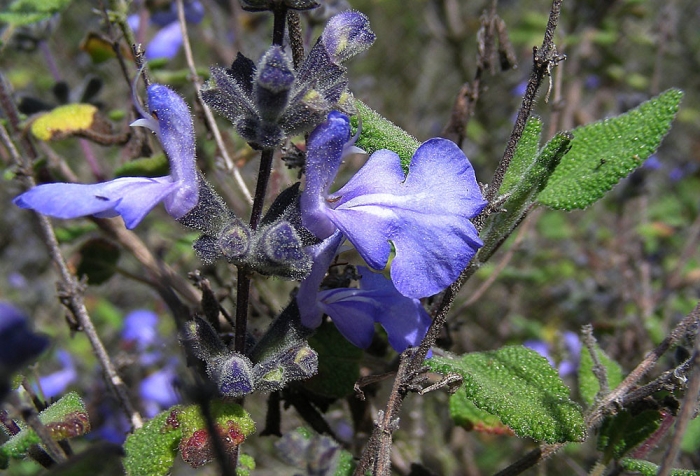Grape-Scented Sage
(Salvia melissodora)
Grape-Scented Sage (Salvia melissodora)
/
/

Dick Culbert
CC BY 2.0
Image By:
Dick Culbert
Recorded By:
Copyright:
CC BY 2.0
Copyright Notice:
Photo by: Dick Culbert | License Type: CC BY 2.0 | License URL: https://creativecommons.org/licenses/by/2.0/ | Uploader: Dick Culbert | Publisher: Flickr |































Estimated Native Range
Summary
Salvia melissodora, commonly known as Grape-Scented Sage, is a semi-deciduous subshrub or shrub native to the mountainous regions of Mexico. It typically grows up to 6 feet high and 4 feet wide, with a graceful and upright habit. The foliage is aromatic, and when partially dry, it emits a pleasant fragrance reminiscent of mint. The flowers, blooming from late spring until frost, are arranged in short inflorescences with several whorls. Each flower exhibits a violet-lavender upper lip and a pale lavender lower lip, with the back of the upper lip also pale lavender. These blooms are highly attractive to pollinators due to their abundant nectar, drawing bees, butterflies, and hummingbirds.
Grape-Scented Sage is valued for its aromatic leaves and long blooming period, making it a favorite for sensory gardens and pollinator-friendly landscapes. It is often used in border plantings, as an accent in herb gardens, or for naturalizing in informal settings. This plant thrives in full sun to part shade and prefers low water once established, adapting well to soils with medium drainage. While it is generally low-maintenance, it may require protection from frost in colder climates. Pruning in late winter can help maintain its shape and promote vigorous growth.CC BY-SA 4.0
Grape-Scented Sage is valued for its aromatic leaves and long blooming period, making it a favorite for sensory gardens and pollinator-friendly landscapes. It is often used in border plantings, as an accent in herb gardens, or for naturalizing in informal settings. This plant thrives in full sun to part shade and prefers low water once established, adapting well to soils with medium drainage. While it is generally low-maintenance, it may require protection from frost in colder climates. Pruning in late winter can help maintain its shape and promote vigorous growth.CC BY-SA 4.0
Plant Description
- Plant Type: Subshrub, Shrub
- Height: 4-6 feet
- Width: 3-4 feet
- Growth Rate: Moderate
- Flower Color: Blue
- Flowering Season: Fall, Spring, Winter
- Leaf Retention: Semi-Deciduous
Growth Requirements
- Sun: Full Sun, Part Shade
- Water: Low
- Drainage: Medium
Common Uses
Bee Garden, Bird Garden, Border Plant, Butterfly Garden, Deer Resistant, Drought Tolerant, Edible*Disclaimer: Easyscape's listed plant edibility is for informational use. Always verify the safety and proper identification of any plant before consumption., Fragrant, Hummingbird Garden, Low Maintenance, Potted Plant, Rabbit Resistant, Rock Garden
Natural Habitat
Native to the mountainous regions of Mexico
Other Names
Common Names: Tarahumara
Scientific Names: , Salvia melissodora, Salvia scorodoniifolia, Salvia dugesii, Salvia scorodoniifolia var. crenaea, Salvia scorodonia,
GBIF Accepted Name: Salvia melissodora Lag.